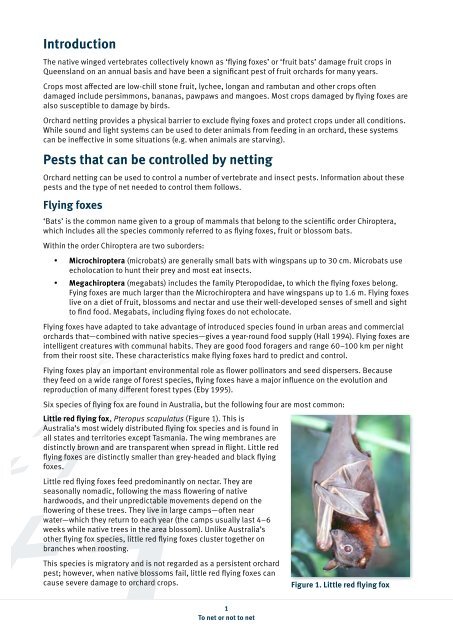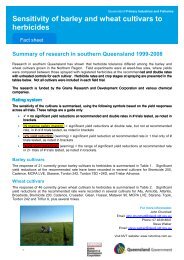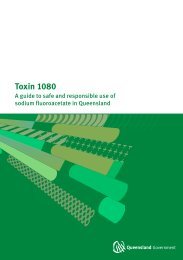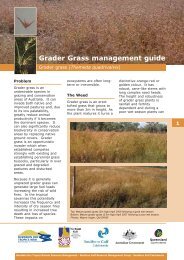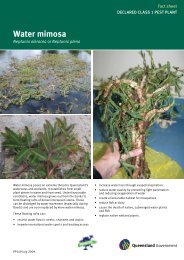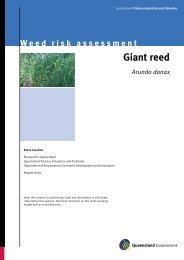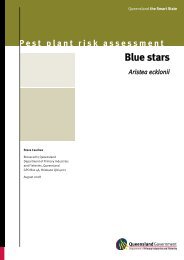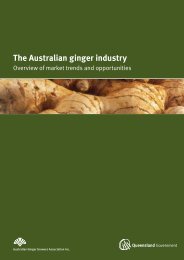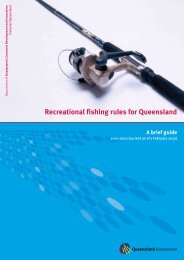To net or not to net - 3rd edition - Department of Primary Industries
To net or not to net - 3rd edition - Department of Primary Industries
To net or not to net - 3rd edition - Department of Primary Industries
Create successful ePaper yourself
Turn your PDF publications into a flip-book with our unique Google optimized e-Paper software.
Introduction<br />
The native winged vertebrates collectively known as ‘flying foxes’ <strong>or</strong> ‘fruit bats’ damage fruit crops in<br />
Queensland on an annual basis and have been a significant pest <strong>of</strong> fruit <strong>or</strong>chards f<strong>or</strong> many years.<br />
Crops most affected are low-chill s<strong>to</strong>ne fruit, lychee, longan and rambutan and other crops <strong>of</strong>ten<br />
damaged include persimmons, bananas, pawpaws and mangoes. Most crops damaged by flying foxes are<br />
also susceptible <strong>to</strong> damage by birds.<br />
Orchard <strong>net</strong>ting provides a physical barrier <strong>to</strong> exclude flying foxes and protect crops under all conditions.<br />
While sound and light systems can be used <strong>to</strong> deter animals from feeding in an <strong>or</strong>chard, these systems<br />
can be ineffective in some situations (e.g. when animals are starving).<br />
Pests that can be controlled by <strong>net</strong>ting<br />
Orchard <strong>net</strong>ting can be used <strong>to</strong> control a number <strong>of</strong> vertebrate and insect pests. Inf<strong>or</strong>mation about these<br />
pests and the type <strong>of</strong> <strong>net</strong> needed <strong>to</strong> control them follows.<br />
Flying foxes<br />
‘Bats’ is the common name given <strong>to</strong> a group <strong>of</strong> mammals that belong <strong>to</strong> the scientific <strong>or</strong>der Chiroptera,<br />
which includes all the species commonly referred <strong>to</strong> as flying foxes, fruit <strong>or</strong> blossom bats.<br />
Within the <strong>or</strong>der Chiroptera are two sub<strong>or</strong>ders:<br />
• Microchiroptera (microbats) are generally small bats with wingspans up <strong>to</strong> 30 cm. Microbats use<br />
echolocation <strong>to</strong> hunt their prey and most eat insects.<br />
• Megachiroptera (megabats) includes the family Pteropodidae, <strong>to</strong> which the flying foxes belong.<br />
Fying foxes are much larger than the Microchiroptera and have wingspans up <strong>to</strong> 1.6 m. Flying foxes<br />
live on a diet <strong>of</strong> fruit, blossoms and nectar and use their well-developed senses <strong>of</strong> smell and sight<br />
<strong>to</strong> find food. Megabats, including flying foxes do <strong>not</strong> echolocate.<br />
Flying foxes have adapted <strong>to</strong> take advantage <strong>of</strong> introduced species found in urban areas and commercial<br />
<strong>or</strong>chards that—combined with native species—gives a year-round food supply (Hall 1994). Flying foxes are<br />
intelligent creatures with communal habits. They are good food f<strong>or</strong>agers and range 60–100 km per night<br />
from their roost site. These characteristics make flying foxes hard <strong>to</strong> predict and control.<br />
Flying foxes play an imp<strong>or</strong>tant environmental role as flower pollinat<strong>or</strong>s and seed dispersers. Because<br />
they feed on a wide range <strong>of</strong> f<strong>or</strong>est species, flying foxes have a maj<strong>or</strong> influence on the evolution and<br />
reproduction <strong>of</strong> many different f<strong>or</strong>est types (Eby 1995).<br />
Six species <strong>of</strong> flying fox are found in Australia, but the following four are most common:<br />
Little red flying fox, Pteropus scapulatus (Figure 1). This is<br />
Australia’s most widely distributed flying fox species and is found in<br />
all states and territ<strong>or</strong>ies except Tasmania. The wing membranes are<br />
distinctly brown and are transparent when spread in flight. Little red<br />
flying foxes are distinctly smaller than grey-headed and black flying<br />
foxes.<br />
Little red flying foxes feed predominantly on nectar. They are<br />
seasonally nomadic, following the mass flowering <strong>of</strong> native<br />
hardwoods, and their unpredictable movements depend on the<br />
flowering <strong>of</strong> these trees. They live in large camps—<strong>of</strong>ten near<br />
water—which they return <strong>to</strong> each year (the camps usually last 4–6<br />
weeks while native trees in the area blossom). Unlike Australia’s<br />
other flying fox species, little red flying foxes cluster <strong>to</strong>gether on<br />
branches when roosting.<br />
This species is migrat<strong>or</strong>y and is <strong>not</strong> regarded as a persistent <strong>or</strong>chard<br />
pest; however, when native blossoms fail, little red flying foxes can<br />
cause severe damage <strong>to</strong> <strong>or</strong>chard crops. Figure 1. Little red flying fox<br />
1<br />
<strong>To</strong> <strong>net</strong> <strong>or</strong> <strong>not</strong> <strong>to</strong> <strong>net</strong>


